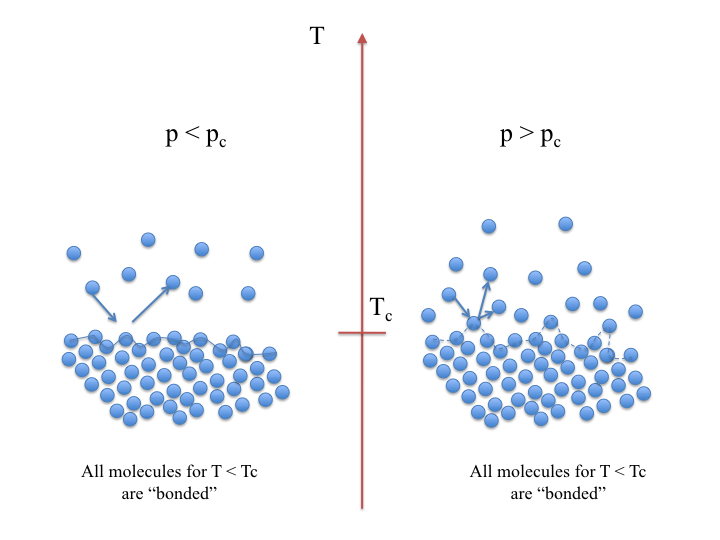The point is that when there is only a single phase there is no dividing surface that could hold any surface tension. One has surface tension precisely when a liquid and a gas phase (in general also two liquid phases would be possible) are present simultaneously. This holds only along the coexistence curve in the lower left corner of your phase diagram.
Along your upper path one never meets this line, so one always has a single homgeneous phase without any intrinsic boundary surface. This is also true at almost all points on your lower path - with the exception of the single point where you path meets the coexistence curve.
Upon crossing that point, your liquid starts to boil, and the temperature stalls at the boiling point until the whole liquid is vaporized. During this time, the liquid and gas phase coexist (hence the name coexistence curve), and one has surface tension along any interface surface between the two phases.
Once the boiling point has been passed, there is again only a single gas phase, and no boundary surface exists anymore.
On the molecular level, the statistical arrangement of a fluid in equilibrium has uniform properties at most points of the phase diagram, which usually change continuously with pressure and temperature. Exceptions are precisely the coexistence curves, where there are two (and at a triple point even three) different phases of different density (and hence statistical arrangement) that are thermally equivalent. This means that they carry the same chemical potential and hence can be in equilibrium with each other.
Along such a coexistence curve, one needs a third parameter (the density) to determine the state and the proportions of the fluid that are liquid and gaseous. Upon crossing the coexistence curve while heating (cooling), the proportion of liquid changes from 1 to 0 (from 0 to 1) to cross the discontinuity in structure, and energy is needed (set free) to enable this structural change. Thus again everything happens continuously, though in a less obvious manner.
All this assumes being at equilibrium, i.e., at constant temperature, changed so slowly that equilibrium is maintained throughout the process. (Difficult to in practice; see below.) In case of a temperature gradient,
''a single fluid in a constant pressure system and with a temperature gradient from sub-critical temperatures to super-critical temperature'', the above applies locally in sufficiently small regions each of which may be considered to have constant temperature.
Globally, this is a very unstable situation, turbulence will develop, which looks very different from your top diagram. There is no simple dividing surface of the kind you are drawing!
You can see what happens by putting a pot of water on a stove and heating it until it boils. (Hold your diagrams upside down to match it with the experiment.) Standard kitchen pressure is subcritical, but you cann see from your experiment that you won't be able to observe the left hand side of your diagram. Thus there is no reason to expect that at higher pressure you'd observe the right hand side.


